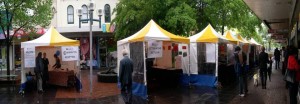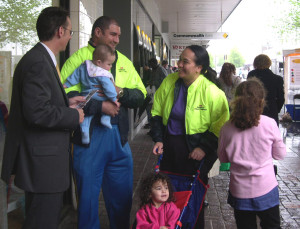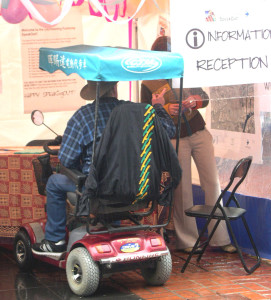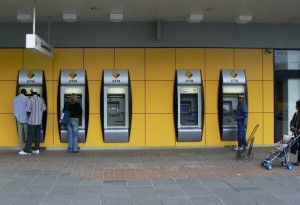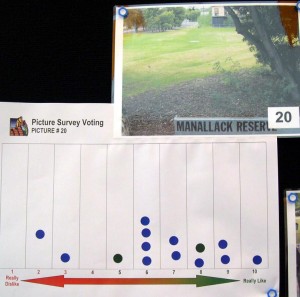Staffing
This model depends on having one Listener and one Recorder at each issue stall, as well as other staff to assist with various aspects.
Without this level of staffing, the SpeakOut will be nothing more than a staffed exhibition. It requires considerable staffing resources to design and mount the event, as well as for analysis of findings.
Accessibility
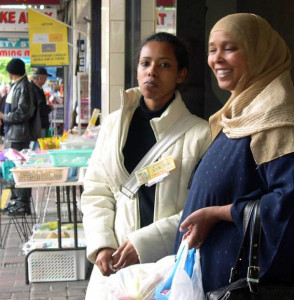
This model lends itself to wide community participation. The `drop-in’ format maximizes attendance, as people are free to participate at a convenient time.
It is especially accessible to people in low-income communities where there may be low levels of formal literacy. It can provide training and paid employment for local people, as well as the potential for community enterprise development.
The model also works well with a wide range of community groups, particularly if attention is payed to catering for local language/cultural groups (for example, engaging bilingual translators as Listeners and Recorders).
A SpeakOut is effective with those who rarely if ever are accommodated in more mainstream processes: children, young people, new immigrants, visitors to the area (shoppers or pub goers, for example), homeless people and so forth.
These processes work well for children and adults alike. Some features, including `Vote with Your Hands’ (see Chapters 6 and 8), enable community members (especially children and young people) to provide their ideas, even in communities with low levels of literacy or low proportions of English-speaking residents.
Physical accessiblity is also every important. We ensure that all stalls and the whole event are wheelchair accessible and we do what we can to assist people with other impairments.
Part of a larger process
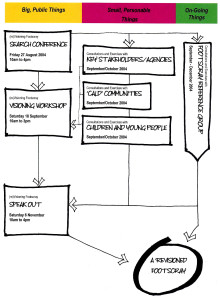
We have never used a SpeakOut as a stand-alone process and emphasize the importance of building a SpeakOut into a wider community engagement program.
One event cannot perform miracles!
Further, there are some issues which demand a `town meeting’ forum, where everyone can get together and be heard in the same meeting or workshop.
Ideally, a process would include both such a workshop and a SpeakOut, among other processes.
It can be used at the beginning, middle or end of an engagement process: for example, in the early stages of a participation process to gather ideas (issue identification) or in later stages where the results of studies/planning are being communicated back to community members
Location, location, location
The five Commonwealth Bank ATMs on Nicholson Mall proved to be the best drawcard to our SpeakOut on a rainy Friday afternoon!
We have used this model in a wide range of different settings: indoors in rooms and halls and outdoors, using temporary venues such as tents and marquees. We have used one large marquee or several small ones, both with good effect.
Finding the right location is a critical compent of a SpeakOut.
The idea is to take the event to the people, not to expect them to come to the event.
A SpeakOut can occur in a train station, a mall or on the footpath. In one memorable event, the location was beside five bank ATMs. On a busy Friday afternoon, everyone came to get money of the weekend and they spoke out as well!
Displays
The individual stalls and the displays at SpeakOut stalls are the backbone or basic structure of the SpeakOut model.
They can take many forms, including displaying information describing the stages and timing of the process, displaying information illustrating site analyses and other information or data about the site and the project, survey results, past planning, research and design work or other appropriate information.
And, of course, there will be tailor-made displays designed for interactive exercises.
It’s critical that all of this material be produced using friendly and eye-catching graphics. It’s important to resist the temptations of a `one size-fits-all’ approach or standardized graphics.
The highly successful graduate planning student SpeakOut described in Chapter 4.5 shows how effective hand-made signs and displays can be in a SpeakOut setting.
Bold, large issue stall signs (for example, Vandalism, Traffic Safety, Children’s Play) and display space (pin boards, tables and chairs) are all important components discussed in detail later in this book.
Adding to the effectiveness of displays can be issue `prompts’ (for example, annotated photos, provocative questions and points related to the issue), an annotated map of the study area with transparent overlays for community comments at each issue stall and, of course, props for the selected children’s engagement process.
Logistics, tools and props
The SpeakOut is highly dependent on careful planning and logistical support. As some of the case studies in Chapter 4 illustrate, it’s sometimes challenging for novices to design and manage a SpeakOut without expert advice.
The props used to support a SpeakOut are described in detail in the checklists included in this book.
It’s important to pay attention to the design of materials such as participant sign-up sheets, green sheets for comments and sign-up sheets for membership of community advisory or reference groups.
Entertainment
 Entertainment and special activities are important SpeakOut drawcards.
Entertainment and special activities are important SpeakOut drawcards.
To ensure balanced intergenerational participation, we provide engagement and entertainment activities for children and young people.
Acoustics are always a concern, however.
Don’t let the music drown out the voices of participants.
